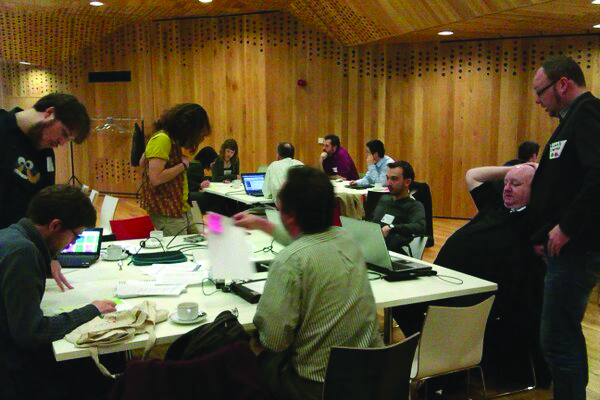TRIPLE HELIX (3H): Where are Europe’s cities standing?
Edited on
24 June 2019The triple helix (3H) of university-industry government relations has become one of the most popular innovation models in the last two decades. What is the relevance for cities? How can they grow their economies using triple helix approaches? What can we learn from cases across Europe and from URBACT networks that dealt with this theme?

We speak of a triple helix when governments and companies work together with knowledge institutions, similar to the strings in DNA. The helix is used as an image to illustrate a complex network of relationships rather than three connections arrived at by placing the three sectors in a triangle. The thesis is that business, academia and government still fulfil their core traditional functions, but collaborate dynamically at the same time. It’s not just working together on an ad hoc or project basis: the cooperation is supposed to be more institutional, structured and strategic. And at times, they ‘take the role of the other’ by adopting new, non-traditional roles; for example, companies become educators (i.e. by training students) and the university becomes more entrepreneurial. In the triple helix model, knowledge does not only flow from university lab to the business (the traditional ‘linear’ model of innovation): there are multiple links, flows and backflows between multiple partners that make up a complex tissue of public, private and knowledge actors.
More recently, the term ‘quadruple helix’ has been used, in which the fourth helix is represented as civil society, whereby the end user (which may be the citizen, the consumer, the patient, depending on the situation) enters the equation and becomes directly involved in the innovation process as well. The quadruple helix opens up issues around the nature of demand and may also move innovation from having a narrow technological orientation towards a more societal focus.
Triple helix helps to speed up innovation in the industry
Many cities and regions have seen organising and optimising their helices as a priority. Importantly, all European regions are required to develop a Smart Specialisation strategy as part of their ex-ante conditionalities in their operational programme.
 There are good reasons to assume that a well organised triple helix helps to build stronger and more innovative urban and regional economies, meaning more jobs, more prosperity, and a bigger tax base[i]. When universities and firms join forces, knowledge flows faster, R&D is less fragmented, curricula become better aligned to business needs, start-ups have higher chances of survival, and the region can develop a stronger profile. Very importantly, triple helix partnerships can help to speed up the ‘commercialisation’ of scientific research (van Winden et al., 2014).
There are good reasons to assume that a well organised triple helix helps to build stronger and more innovative urban and regional economies, meaning more jobs, more prosperity, and a bigger tax base[i]. When universities and firms join forces, knowledge flows faster, R&D is less fragmented, curricula become better aligned to business needs, start-ups have higher chances of survival, and the region can develop a stronger profile. Very importantly, triple helix partnerships can help to speed up the ‘commercialisation’ of scientific research (van Winden et al., 2014).
A good example of the latter can be found in Heidelberg, Germany. 3H partners joined forces and founded the ‘InnovationLab’, back in 2011. About 100 scientists from universities and companies work on R&D projects in the field of printed and organic electronics. The research is interdisciplinary and applied. The lab supports the printing and electronics industry in the wider region, and helps participating firms to stay at the technological frontier in this competitive market. “We can deploy our resources more effectively thanks to the common infrastructure; it helps us to speed up our development time’, says Bjorn Hofman, Senior Vice President at Merck, one of the participating firms; "The collaborative R&D speeds up the transfer of knowledge into commercial products, and is an ideal basis for growth promotion". The InnovationLab is a joint effort of many players. The Metropole region Rhein-Neckar (of which Heidelberg is part) took the initiative to set it up; it mainly played a facilitating role, bringing the partners together, and providing spaces and permits for the buildings. The universities and the firms carry out the core work: main shareholders are big technology companies (Merck and BASF have 70% of the shares), and work together with the universities of Heidelberg and (neighbouring) Mannheim. Substantial financial support came from the region (€40 m) and the state level.
Professor Emmo Meijer, a seasoned ‘3H builder’ as former R&D director at Unilever and DSM, sees the great value of the concept. In a recent speech, he underlined that the metropolitan region (rather than the city or the nation) is becoming the relevant level for the triple helix to operate. Regions that manage to build strong 3H networks offer an attractive research environment where the best talents love to work: “if you want to attract entrepreneurial top researchers, you need to have such innovative partnerships in place”, he said[ii].
One might wonder who benefits most from these types of triple helix collaborations. At face value, isn’t the triple helix just another type of state support for (big) firms? Research collaboration helps them to have expensive R&D carried out at the costs of the taxpayer, by publicly funded knowledge organisations. Should the helix enable large companies get a bigger say in setting university research agendas? These are valid points of concern. Addressing them, Loet Leydesdorf (one of the godfathers of the 3H concept) stresses that each organisation must keep its identity and stand for its own mission. But even then, the risk is certainly there, especially when companies get a big say in research programming. “Can research questions be generated and research programmes be articulated in relation to external demand? The articulation of knowledge interests implies a shift from the ‘how’ question of the process to ‘what’ and ‘why’. Here ‘what’ and ‘why’ can facilitate research, whereas ‘how’ can easily degenerate into a procedure”[iii].
Is the triple helix approach relevant for all cities?
The Heidelberg example above represents somehow the ‘champions league’ of Europe’s knowledge economy: multinational companies with big R&D budgets, joining up with top universities, backed by national research funds, in a region with a longstanding innovation track record. This is all fine, but is there scope for less advanced and peripheral regions to gear up their economies through helices?
 First, in any place, 3H partnerships can help to improve the match between higher education and the needs of local firms. This is pressing in parts of Central and Southern Europe where, in general, university education is still highly theoretical, and little interaction with industry happens. A triple helix partnership might change the stalemate. An interesting case is Cluj-Napoca, in Romania. Companies in the city’s growing local IT industry were hiring, but expressed their discontent with the skills of the universities’ graduates. The local universities, led by pro-active rectors (an important factor!), were ready to change and adapt their curricula, but did not want to speak to each company individually. They asked the fragmented IT industry to speak with one voice. Hence the idea emerged to join forces in a more structured manner. Universities teamed up with the local IT industry and public organisations, to create a cluster organisation, the Cluj IT Cluster. Currently, the cluster is made up of 32 companies, three regional universities, and eight partner organisations (including the Regional Development Agency, the City Council of Cluj-Napoca and county-level institutions in Cluj). It has turned into a platform where the triple helix partners meet, discuss common challenges, and develop joint activities and projects. Internships were developed, and curricula adapted, and all sorts of joint innovation projects have started. The city played the role of facilitator and network-mediator.
First, in any place, 3H partnerships can help to improve the match between higher education and the needs of local firms. This is pressing in parts of Central and Southern Europe where, in general, university education is still highly theoretical, and little interaction with industry happens. A triple helix partnership might change the stalemate. An interesting case is Cluj-Napoca, in Romania. Companies in the city’s growing local IT industry were hiring, but expressed their discontent with the skills of the universities’ graduates. The local universities, led by pro-active rectors (an important factor!), were ready to change and adapt their curricula, but did not want to speak to each company individually. They asked the fragmented IT industry to speak with one voice. Hence the idea emerged to join forces in a more structured manner. Universities teamed up with the local IT industry and public organisations, to create a cluster organisation, the Cluj IT Cluster. Currently, the cluster is made up of 32 companies, three regional universities, and eight partner organisations (including the Regional Development Agency, the City Council of Cluj-Napoca and county-level institutions in Cluj). It has turned into a platform where the triple helix partners meet, discuss common challenges, and develop joint activities and projects. Internships were developed, and curricula adapted, and all sorts of joint innovation projects have started. The city played the role of facilitator and network-mediator.
Second, triple helix structures may benefit smaller and medium sized firms which are typically less innovative as well. Such firms have often problems to stay competitive as they lack innovation resources and the capacity to use R&D even at the level of technology transfer. They rarely carry out any R&D and often would not know how to approach the university even if they want to. How to make the relationship work for both sides? The URBACT EUniverCities network identified several examples. In the German city of Aachen, for example, university professors connect to SMEs through the ‘profs on tour’ initiative: professors visit SMEs in the region, discuss about their research, and actively look for collaboration opportunities, ranging from student internships to long-term innovation projects. In the city of Tampere, also a partner of EUniverCities, the technical university organises ‘Problem Fridays’ since September 2014. SMEs are actively approached and invited to a one hour session on a Friday afternoon, where they can bring a problem or question, to be discussed with a team of university experts. By the end of the hour, it must be clear if there is scope for some sort of collaboration, and if so the partners arrange for next steps.
What can cities do when it comes to the triple helix?
Typically, cities don’t control the university, and unlike national government, they don’t have big R&D funding leverage; and they cannot (and should not) tell companies and universities with whom to collaborate. So, much depends on the leadership and pro-active attitude of the local companies and universities, and their willingness/determination to join up.

Having said that, cities can do a lot when it comes to the triple helix. First, cities can activate the local university and their students to contribute to the local economy. The case study on San Sebastian in this publication provides a very practical example. Fomento, the economic development agency of the city, challenged university students and their supervisors to prototype new surfing products (focusing on boards and accessories), and to involve end-users in the process. It was a big success; more than 100 ideas were proposed by student teams, and the eighteen best ones were selected to be prototyped. Many of the participating teams proved to be fanatic surfers themselves, and they loved to work on this. The winners gained a support package to set up their own business, including access to start-up funds, and got the opportunity to closely work with mature companies in the field.
"Triple helix approaches are a fundamental pillar of the new smart specialisation approach to regional development set out in cohesion policy. Cities have a major opportunity to position themselves as a lead player in this type of helix."
Second, cities can initiate and support ‘intermediate’ organisations that bridge the gap between business/society and education. The textbook example is Demola, in Tampere (Finland). Demola is a collaboration between the city, its universities, and a number of other local stakeholders. The Demola organisation collects research questions and challenges from a variety of organisations in Tampere (companies, hospitals, government agencies, NGOs, etc). It publishes the assignments on a website, including the type of skills that are asked for. Students are invited to subscribe to a project. Demola then assembles student teams to address the projects, and offers a range of support and training activities for the student teams. Demola is an internationally recognised best practice programme that has been copied in several other cities. “There are about 38,000 students in universities around Tampere”, says Ville Kairamo, co-founder of Demola. “But there was no organisational structure to mobilise that young talent and help students work together. With Demola we wanted to offer concrete projects where students learn by doing”.
Third, municipalities can contribute to turn the city into a ‘living lab’. Living labs are real-life test and development settings, where researchers and/or companies can try out new technologies, products and services, in collaboration with citizens. This sounds easy but is hard: it often turns out that our heavily regulated society is not that fit for trying out new concepts in real life: loads of detailed rules and regulations may frustrate progress. This is epitomised by contemporary urban technology (or ‘smart city’) pilots. Nevertheless, cities can support the creation of experimentation arenas or urban innovation labs, in which new concepts are tried out with in a protected way, with an eye to give breathing space to new concepts and involve citizens in the process.
Fourth, cities can help to realise knowledge hotspots: science parks, campuses, or similar developments where business and academia work side by side. The URBACT REDIS network focussed on this theme, and documented a number of good practices.
What does it take? Is the city prepared? Some questions

The triple helix is about institutionalised and structured co-operation between university, companies, and government. How well does your city staff know and understand the contemporary university and business world? Helices can only work when the constituent organisations trust each other, and are prepared to ‘take each other’s role’ if necessary. Is the city a trusted partner for local companies and for the university? Cities are often perceived as bureaucratic and rigid organisations. A triple helix asks for a more entrepreneurial orientation of all the players involved. Do you know who the entrepreneurial ‘change agents’ are in the university? Can you give them a platform to realise their ambitions? Do you have the competent and motivated civil officers to set up and stimulate such partnerships?
Triple helix approaches are a fundamental pillar of the new smart specialisation approach to regional development set out in cohesion policy. Cities have a major opportunity to position themselves as a lead player in this type of helix. However, like all approaches the devil is in the detail, and successful cities have been those that have been able to bridge the institutional divides that historically have separated the three main types of actors. Calling yourself a triple helix is not enough, you have to become one!
To find out all the questions on this section and read the full article please click here.
By: Willem van Winden and Luis de Carvalho
Photo Source: Dublinked and Freepik
Read More:
New Urban Economies: How can cities foster economic development and develop 'new urban economies' - URBACT Capitalisation
New Urban Economies - Video
The Open Data economy: promoting digital innovation in Dublin - URBACT Capitalisation
New style cluster policy: riding the waves of San Sebastian's surf economy - URBACT Capitalisation
[i] Although it must be noted that there is no definitive scientific proof for this
[ii] Quote from his speech in Amsterdam, 12 November 2014, during the opening of a new technology transfer organisation
[iii] Interview with Scientometrics (2014), 99:199–202
 Submitted by Willem van Winden on
Submitted by Willem van Winden on




